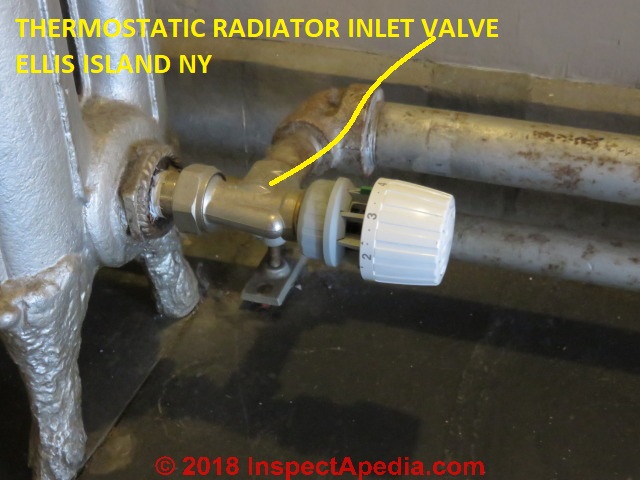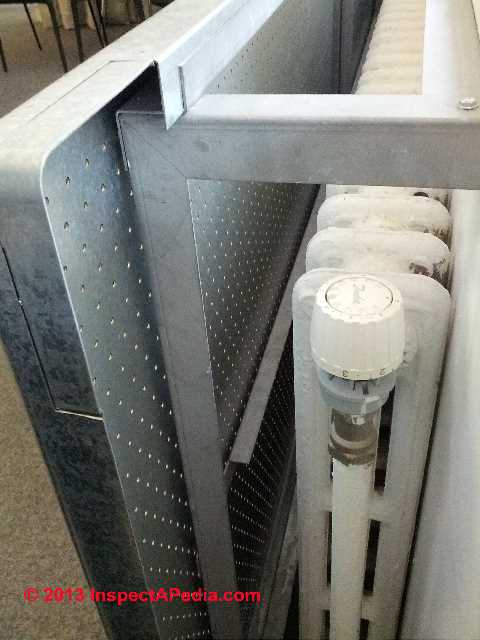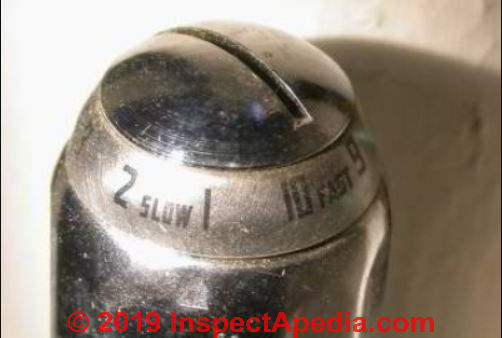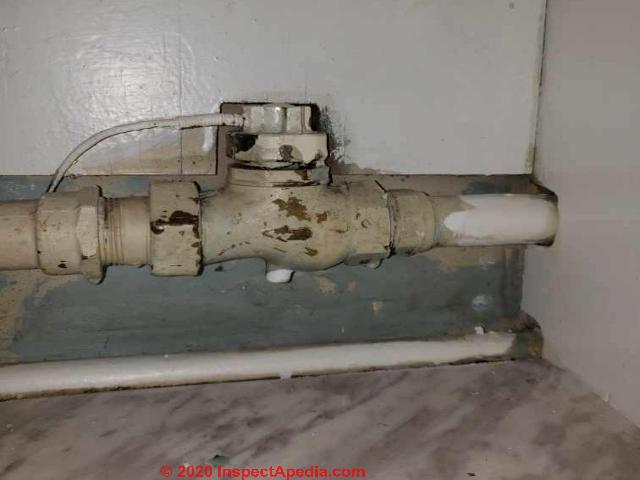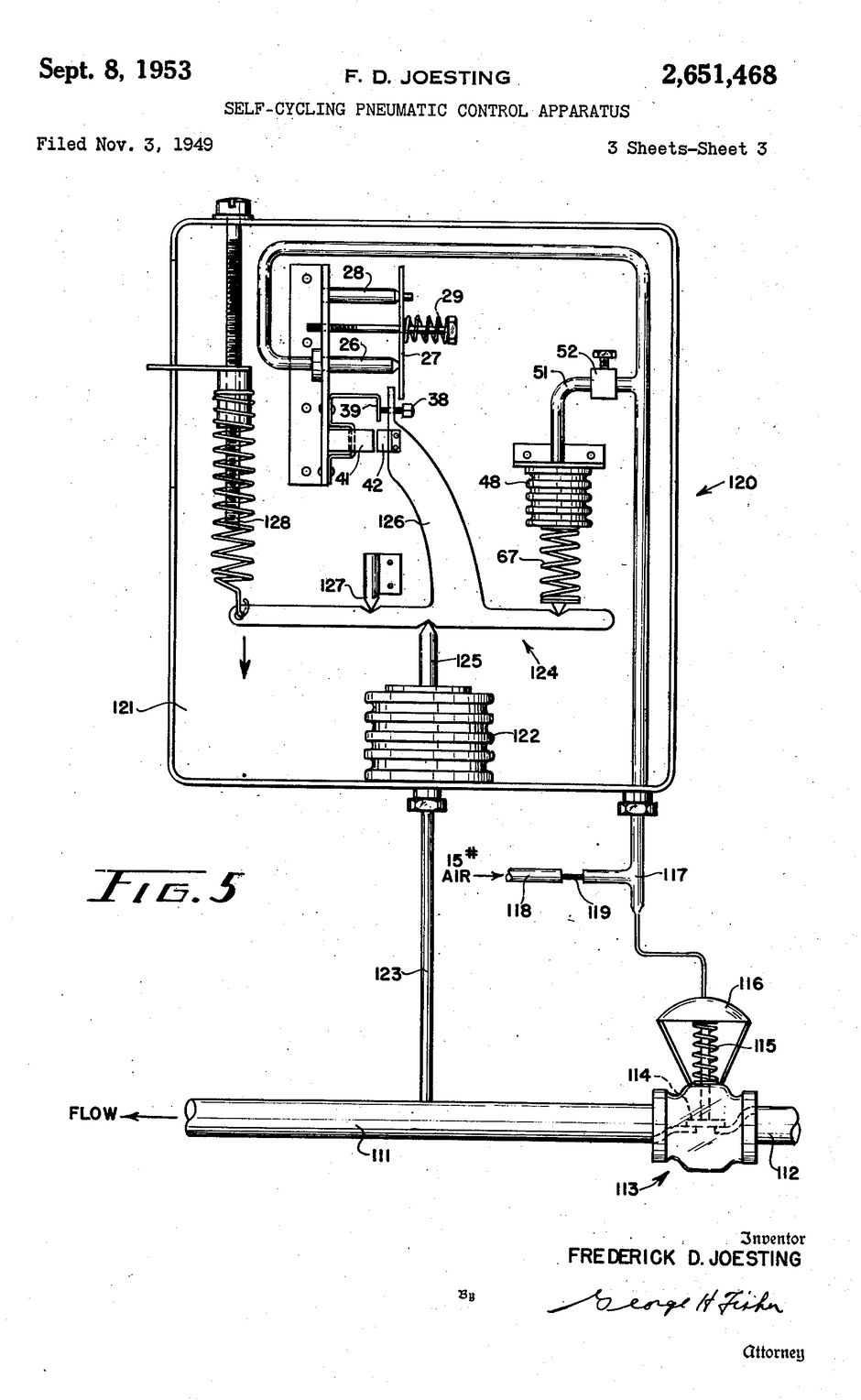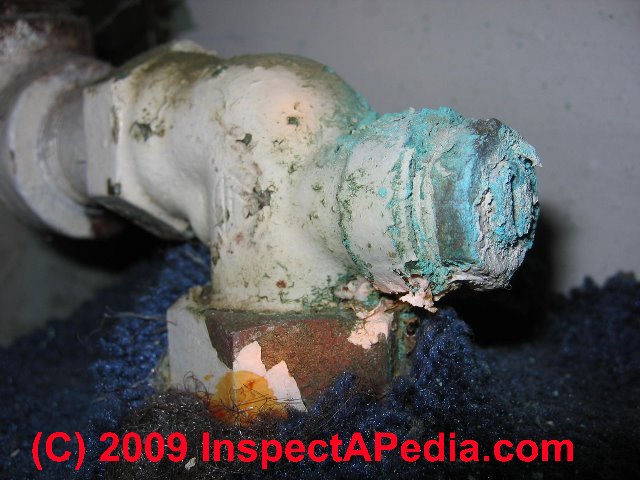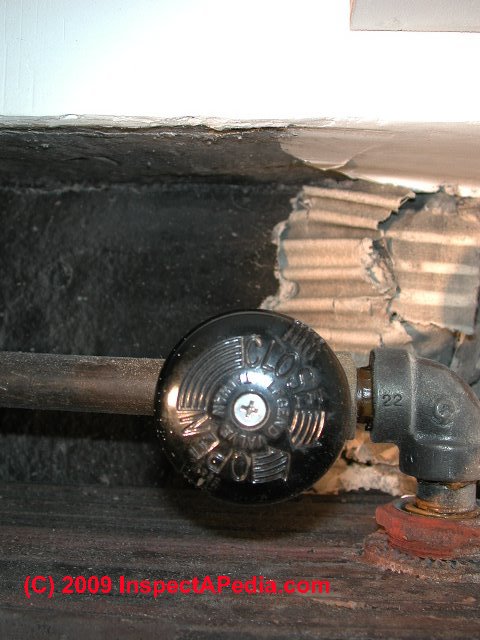 Radiator Valve Types: Hot Water vs Steam
Radiator Valve Types: Hot Water vs Steam
What kind of heating radiator & valve do I have?
- POST a QUESTION or COMMENT about types of radiator valves for both hot water and steam heat systems
Radiator valve type identification: do I have hot water heat or steam heat?
This article series explains the use, adjustment, diagnosis & repair of hot water or steam heating radiator valves & steam vents to control heat output from individual radiators.
What to do about hot water or steam radiator valves or vents that are stuck open or closed.
InspectAPedia tolerates no conflicts of interest. We have no relationship with advertisers, products, or services discussed at this website.
- Daniel Friedman, Publisher/Editor/Author - See WHO ARE WE?
Types of Radiator Valves: Hot Water vs Steam
Hot Water Heat Radiator Valves
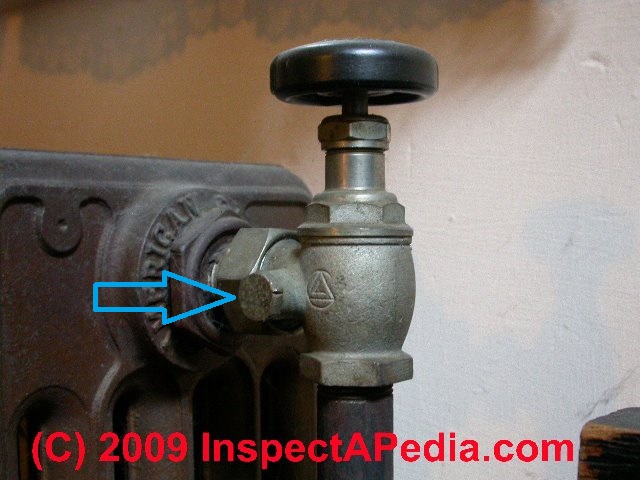
In our photo just above you can see not only the radiator control valve, but lots more information:
This radiator is being fed from the top. We know that this must be either a hot water radiator or a two pipe steam heat radiator.
Now look closely at that air bleeder connector on the side of the radiator valve.
From this detail we can conclude that this is a hot water heating system, not a steam heat system
Hot water can enter a hot water (hydronic) heating radiator at the radiator top or bottom.
Hot water radiators may have an air bleeder valve but never a steam vent valve.
Steam can enter a steam heating radiator at the radiator top, too, (most but possibly not all two pipe steam heat systems) or also at the radiator bottom (one pipe steam heat systems).
Steam Radiator Control Valves
Above: a typical inlet control valve found at the bottom inlet end on a one pipe steam heat radiator.
Our next photo shows one of two common locations for steam radiator valves: at the radiator bottom at one end:
Below: a thermostatically controlled steam inlet valve at the bottom inlet of an antique two pipe steam heating system radiator that we inspected on New York's Ellis Island.
On some steam radiators, particularly some two pipe steam system radiators, you may find the steam inlet control valve at the top of one end of the radiator rather than the bottom, as you can see in our photo below, taken at Google's Headquarters building in New York City.
We describe automatic steam radiator control valves
If your steam radiators won't get hot see COLD STEAM HEAT RADIATORS for help in diagnosing and fixing steam radiators that won't get hot. Excerpts from that article are found below.
See STEAM RADIATOR PIPING CONNECTIONS for an explanation of different types of steam piping and steam-radiator piping connections.
Also see STEAM VENTS since some of these, like the Dole steam vent shown below, are adjustable and so provide additional control over the steam radiator heat output.
In-Line Hydronic Heat Control Valves - Pneumatic or Vacuum or Electric
Question: identify this hot water heating control valve
2020/11/24 Kristina said:
Hello, Could someone help me identify what kind of valve this is?
It is part of a 1957 hydronic heating system. It is in one of the bottom kitchen cupboards in the basement apartment of a triplex.
The metal wire coming out of the top is connected to a knob further down on a baseboard heater that doesn't seem to work in adjusting the temperature.
This Q&A were posted originally
at CHECK VALVES, HEATING SYSTEM
Moderator reply:
 Shown here: a pneumatic or vacuum-operated steam radiator control valve.
Shown here: a pneumatic or vacuum-operated steam radiator control valve.
Kristina
I think that is either an electrical (low voltage) OR a pneumatically-controlled (air-operated or in some models, vacuum-operated) steam valve (or hot water control) that was connected to a room thermostat or other temperature sensor.
Is it possible that your building's heat was originally a steam heating system later converted to forced hot water ? If so, this control could be a left-over.
Look closely: is that metal "wire" coming out of the top of the valve actually a wire or is it a rigid copper tube?
[Click to enlarge any image]
Both types of controls have been used on both hydronic (hot water) and on steam heating systems (wires and pneumatic or copper tubing).
If my guess is right or "sort-of" right, the control in your photo is a cousin to the pneumatic/vacuum operated steam control shown in my photo (above) of a steam radiator installed in Rockefeller Hall on the Vassar College campus in Poughkeepsie NY.
If your heater control no longer responds, the valve itself may be jammed (in which case it will need to be removed entirely or replaced perhaps with a zone valve) or the thermostat or wire that controls it needs to be found and repaired or replaced.
Below we show the Davis patented air valve, one of the earliest air-controlled valve patents that give insight into the history of this device.
- Davis, George M., AIR VALVE [PDF] U.S. Patent No. 404,963 issued June 11, 1990.
Excerpt:
This invention relates more especially to the class of air-valves used on radiators in the system of steam-heating for the purpose of allowing the air to escape and to trap the steam. The valve may be set to act automatically or be adjusted by hand and Worked on the expansion principle.
Above is an example of the type of thermostat that operated pneumatic steam heat control valves described by Joesting's 1953 patent. .
- Joesting, Frederick D. TEMPERATURE RESPONSIVE CONTROL APPARATUS [PDF] U.S. Patent 2,564,222, issued August 14, 1951.
- Joesting, Frederick D. SELF-CYCLING PNEUMATIC CONTROL APPARATUS [PDF] U.S. Patent 2,651,468, issued September 8, 1953.
Hidden Manual Radiator Control Valves on Heating Convectors
On a heating convector unit, there is usually an individual valve that lets the unit be turned down or off - but as our photo (left) shows, the valve can be a little harder to spot.
Unlike a radiator valve, a heating convector control valve may be hidden by the convector's steel cover, or it may be little and hard to recognize as we show here.
This valve, if it's not jammed by corrosion, is operated by a screw driver; it may be possible to get this valve working by gently loosening the lock-nut and then turning the control screw with a flat-bladed screwdriver.
Do not take apart this valve while the heating system is on and hot - you risk getting sprayed with hot water or you may start a leak that's hard to stop without making a mess and having to shut down the whole heating system.
Problem getting the old corroded air bleeder valve out? Or trouble removing a cast iron or steel plug on a radiator where you want to install an air bleeder valve?
See RADIATOR PLUG REMOVAL for a suggested procedure as well as for steps to recover your radiator if the vent mounting hole threads are badly corroded or stripped.
...
Reader Comments, Questions & Answers About The Article Above
Below you will find questions and answers previously posted on this page at its page bottom reader comment box.
Reader Q&A - also see RECOMMENDED ARTICLES & FAQs
How do I fix a leaky steam vent valve
I replaced my steam angle vent because the old one had rusty water bubbling up through the top of the valve.
When I replaced it with a new one, the same problem occurred? Rusty water is bubbling up, not just steam. Any assistance on this would be greatly appreciated. Thank You. -On 2022-04-12 by Mark -
Reply by Inspectapedia Com Moderator (mod)
@Mark,
As we're discussing steam radiators, not hot water rads, it sounds as if your radiator is water-logged; perhaps its concensate return line is blocked.
See details about your vent at
STEAM RADIATOR VENT CLEAN & TEST
and take a look also at the additional steam vent articles suggested at the Recommended Articles section on that page.
Also see CONDENSATE RETURN PIPES, PUMPS, STEAM
Which Radiator Valve Should I Use: Compare Danfoss thermostatic radiator valves with manual globe valves: better hot water flow?
My radiators are equipped with Danfoss thermostatic valves.
Since those valves are sort of globe type valves and I set them always fully open, I wonder whether using simple ball valves instead, will be more effective in terms of better heating the radiators because they do not disturb the water flow as the globe valves do.
From other side, Danfoss valves have a Kv nozzle that might improve the way the water entering the radiators. Please advise. Thanks in advance. - On 2017-12-13 by Chris (komart@hotmail.com) -
Reply by (mod) - get better radiator flow-through with ball valve + Danfoss thermostatic radiator valve.
Chris
I may not understand the situation correctly, but I agree that when there is a thermostatic radiator valve installed one would leave the main valve fully open.
Both ball valves and gate valves are designed to be used in the fully-open or fully-shut position.
If your radiator has a globe valve you'll improve its flow by replacing that with one of the other two designs.For other readers:
Definition of Kv
The Kv-factor is a calculated parameter that gives the capacity of a valve expresed as its water flow through the valve in m3 (or 1000 lites) per hour at a pressure drop across the valve of 1 Bar. Kv is useful when calculating relative pressure drops among different valves used in piping systems.
At PLUMBING CONTROLS & VALVES we explain the differences in operation and flow properties among the three basic plumbing valve designs: globe valves, gate valves, and ball valves.
Because spherical ball valves fully open the water passage when the valve is open these valves do not produce a significant pressure or flow-rate drop across the valve.
See
- Boysen, Herman, Kv: What, WHy, How, Whence?, [PDF] Danfoss, (2011) retrieved 2017/12/12 original source: http://heating.danfoss.com/PCMPDF/VFHBG202_kv.pdf
Followup by Chris
Many thanks for your prompt response. The case is that I have to use the thermostatic radiator valves (TRVs) always fully-open (the thermo-head removed) in order to get maximum possible temperature.
Actually, they do not act as a real TRV, but as globe valves. Since I cannot control parameters like temperature of incoming hot water, its pressure, etc. the only way is to replace the TRV with a ball valve (BV) considering that the latter in fully-open position does not create any “resistance” to the water flow since the diameter of the ball’s hole is the same as the pipe diameter, say 1/2".
As per my understanding, the geometry of the TRV influences some how the flow, requiring it to go in an Z-pattern and because of that the volume of the water passing through the valve, say for a minute, will be less than the one passing through a BV.
From the other side, as I mentioned, the TRV has a Kv nozzle that might improve the way the water enters the radiator and so compensate the smaller water volume compared to that in case of the BV. Thus the query is which valve (TRV or BV) will be more effective in fully-open position. Thank you for considering the issue and providing your advice.
Reply by (mod) - troubleshooting TRVs = Thermostatic Radiator Valves
Chris
Gee that's a very expensive globe valve. IN that case you may as well replace the TRV with a BV just as you suggested.
My OPINION is that a fully open BV with no reduced diameter will provide both the least flow restriction and the most flow-through.The Bernoulli effect achieved by a venturi design can create a lower pressure behind the venturi but I think the available water flow to that point is not going to be increased.
To get beyond arm-waving speculation would be an interesting question to ask of a heating or fluid dynamics engineer.
Can a Kv venturi at a rad valve provide a net gain in hot water flow-through where there remains the constriction of the thermostatic valve (TR) interior?
See this interesting technical analysis
- Petitjean, Robert, M.E., BALANCING OF DISTRIBUTION SYSTEMS [PDF] Great Britain Tour & Andersson Ltd, Barratt House, 668 Hitchin Road, Stopsley Luton, Bedfordshire, LU2 7XH, U.K. Tel: +44 (0)1582 876 232. Fax: +44 (0)1582 488 678. www.tourandersson.com, retrieved 2024/06/19, original source: https://personales.upv.es/vsoto/index_archivos/FTP/Tuberias/TA_Handbook_2_eng.pdf
“Balancing of Distribution Systems” is Manual No. 2 in the TA Hydronics series of publications for HVAC practitioners.
TA Manual No. 1 deals with balancing control loops.
TA Manual No. 3 deals with balancing radiator systems. Manual No. 4 deals with stabilising of differential pressure.
The most efficient methods for balancing waterflows in distribution systems for heating and cooling systems.- Petitjean, Robert, M.E., BALANCING OF RADIATOR SYSTEMS [PDF] a manual for the design, balancing and troubleshooting of hydronic radiator heating systenms [PDF] Sandberg Trygg AB, Sweden., om English from Great Britain Tour & Andersson Ltd, Barratt House, 668 Hitchin Road, Stopsley Luton, Bedfordshire, LU2 7XH, U.K., Tel: +44 (0)1582 876 232. Fax: +44 (0)1582 488 678. www.tourandersson.com
- original source: -
http://www.hydroteam.gr/userfiles/products/TA_Handbook_3_eng_1580016466.pdf original link found in 2017 now dead - Ed. 2024/06/19] - online from Sankom at http://www.sankom.pl/download/dk/documentation/imi/ta/_zeszyt%203%20gb%20nowy.pdf
“Balancing of radiator systems” is the third manual in the TA series of publications about hydronic design and balancing. The first manual deals with balancing control loops, the second with balancing distribution systems and the fourth with hydronic balancing with differential pressure controllers.You could, as a simpler and most-likely less costly approach (where there are multiple radiators involved) look at changing out the hot water circulator pump in the system to install a variable speed model that would let you try driving the hot water piping loop at a faster rate.
That will deliver more BTUs to the same radiator, and I suspect would be more effective than a Kv nozzle / TRV combination. See also
- Danfoss, New Ways of Balancing Two-Pipe Systems [PDF] Danfoss A/S · Heating Segment · Ulvehavevej 61 · 7100 Vejle · Denmark Tel.: +45 7488 8500 · Email: heating@danfoss.com · www.heating.danfoss.com, retrieved 2024/06/19 - copy on file as Two-Pipe-Heat-Balancing-Danfoss.pdf
How to achieve superior hydronic balance in heating systems by utilising the Danfoss Dynamic Valve™ type RA-DV and the Grundfos MAGNA3 speed controlled pump.
We will first look at how we compensate for the variations in partial, and how the requirement to balance the heating system means we need to control flow; and to obtain this, we need to control the differential pressure across valves as well. We will show how this can be done ...
Followup by Chris
Many thanks again for your competent answer and useful information. I have checked the website you kindly provided me with.
After some more investigations it occurred that Danfoss TRV Kv is 0.9 and that of a two-way BV is ca 23 – 26. Thus, the answer of my query is “crystal clear”, namely either to use BV, or to keep TRV, but after removing (if possible) the Kv nozzle….
The latter will allow using the TS head for setting the temperature which could be better than doing that with BV because, as it is written, BVs work fine in either fully closed or fully open position, but not in some intermediate, where problems with the gasket can occur.
I do appreciate your time and efforts taken in considering my case and clarifying it in the best manner. Thanks. Best. Chris
...
Continue reading at RADIATOR VALVE ADJUSTMENT or select a topic from the closely-related articles below, or see the complete ARTICLE INDEX.
Or see RADIATOR VALVE & HEAT CONTROL FAQs - questions and answers posted originally on this page.
Or see these
Recommended Articles
- AIR-BOUND HEATING SYSTEMS - home
- AIR BLEEDER VALVES - home - bleed air out of radiators that are not getting hot
- CHECK VALVES, HEATING SYSTEM - more hot water & steam heat controls
- RADIATOR VALVES & HEAT CONTROLS - find & identify
- AUTOMATIC RADIATOR VALVES - Automatic or Thermostatically Controlled Radiator Valves
- COLD HOT WATER RADIATOR or BASEBOARD - fix cold hot water heat (hydronic) radiators
- STEAM HEAT RADIATOR REPAIR - fix cold steam radiators
- RADIATOR CONTROL VALVES on CONVECTOR HEATERS
- RADIATOR VALVE ADJUSTMENT - How to Adjust or Control the Level of Heat From Radiators
- RADIATOR VALVES MANUAL - Which way to turn the radiator valve
- RADIATOR VALVE STUCK or BROKEN REPAIR - how to repair or replace radiator valves
- RADIATOR VALVE TYPES - hot water, steam, automatic? what's the difference?
- STEAM HEAT VENT CHOICES & INSTALLATION - Adjustable or Thermostatically Controlled
- STEAM VENTS THERMOSTATICALLY CONTROLLED - Used to control steam radiators
- STEAM RADIATOR PIPING CONNECTIONS
Suggested citation for this web page
RADIATOR VALVE TYPES at InspectApedia.com - online encyclopedia of building & environmental inspection, testing, diagnosis, repair, & problem prevention advice.
Or see this
INDEX to RELATED ARTICLES: ARTICLE INDEX to HEATING RADIATORS
Or use the SEARCH BOX found below to Ask a Question or Search InspectApedia
Ask a Question or Search InspectApedia
Questions & answers or comments about using, adjusting, & repairing radiator control valves and vents for both hot water and steam heat systems
Try the search box just below, or if you prefer, post a question or comment in the Comments box below and we will respond promptly.
Search the InspectApedia website
Note: appearance of your Comment below may be delayed: if your comment contains an image, photograph, web link, or text that looks to the software as if it might be a web link, your posting will appear after it has been approved by a moderator. Apologies for the delay.
Only one image can be added per comment but you can post as many comments, and therefore images, as you like.
You will not receive a notification when a response to your question has been posted.
Please bookmark this page to make it easy for you to check back for our response.
IF above you see "Comment Form is loading comments..." then COMMENT BOX - countable.ca / bawkbox.com IS NOT WORKING.
In any case you are welcome to send an email directly to us at InspectApedia.com at editor@inspectApedia.com
We'll reply to you directly. Please help us help you by noting, in your email, the URL of the InspectApedia page where you wanted to comment.
Citations & References
In addition to any citations in the article above, a full list is available on request.
- [1] Dan Holihan, "Your Most Frequently Asked Questions About Cast-Iron Radiators – Answered! by Dan Holohan", http://www.oiltechtalk.com/pages/cast_iron.htm, retrieved 3/7/2013.
- Energy Savers: Heat Distribution Systems, Steam Radiators & Hot Water Radiators, U.S. Department of Energy, web search 12/27/2010, original source: http://www.energysavers.gov/your_home
/space_heating_cooling/index.cfm/mytopic=12580 - Gorton Heating Corporation, 546 South Avenue East, Cranford, New Jersey 07016, Tel: 908-276-1323, email: info@gorton-valves.com, fast venting valves for steam heating systems.
- "Rv-4 One-Pipe Steam Radiator Valve", available from Armstrong International,
816 Maple Street, Three Rivers, MI 49093 USA, Tel: (269) 273-1415, Armstrong has offices in Beijing, China, Belgium, India and Mexico. Web search 12/27/2010, original source:
http://www.armstronginternational.com/thermostatic-valves-rv-4-one-pipe. - [10] Report 95-14, PB96-198163 Thermostatic Radiator Valve (TRV) Demonstration Project, contact NYSERDA. 17 Columbia Circle, Albany, NY 12203-6399 Toll-Free: 1-866-NYSERDA, Tel:(518)465-6252, Ext. 241. Web Search 12/27/2010, original source: http://www.homeenergy.org/archive/hem.dis.anl.gov/eehem/96/960509.html
- [21] Thanks to reader Paul Ruud for discussing improved steam heat controls and thermostatically operated steam radiator valves and air vents, 12/27/2010.
- In addition to citations & references found in this article, see the research citations given at the end of the related articles found at our suggested
CONTINUE READING or RECOMMENDED ARTICLES.
- Carson, Dunlop & Associates Ltd., 120 Carlton Street Suite 407, Toronto ON M5A 4K2. Tel: (416) 964-9415 1-800-268-7070 Email: info@carsondunlop.com. Alan Carson is a past president of ASHI, the American Society of Home Inspectors.
Thanks to Alan Carson and Bob Dunlop, for permission for InspectAPedia to use text excerpts from The HOME REFERENCE BOOK - the Encyclopedia of Homes and to use illustrations from The ILLUSTRATED HOME .
Carson Dunlop Associates provides extensive home inspection education and report writing material. In gratitude we provide links to tsome Carson Dunlop Associates products and services.



